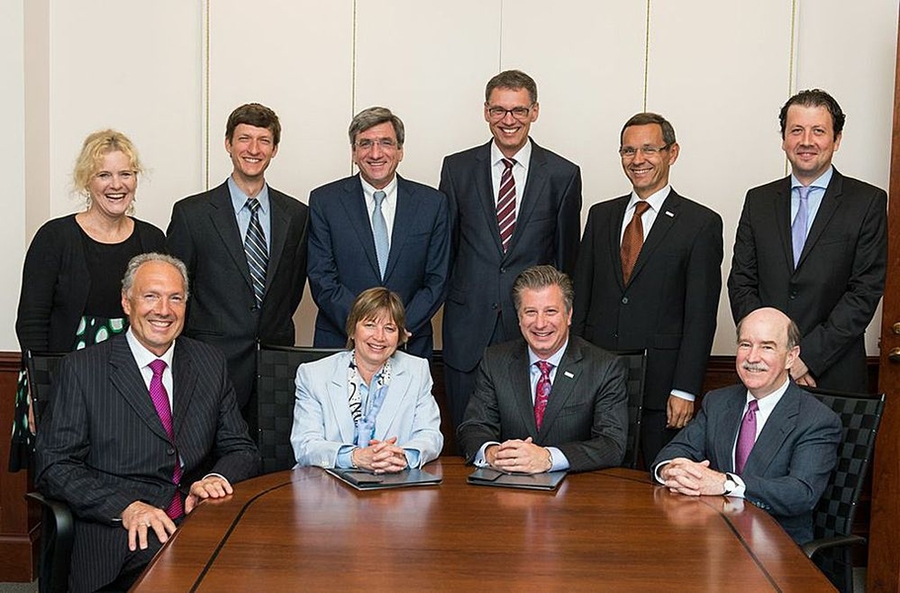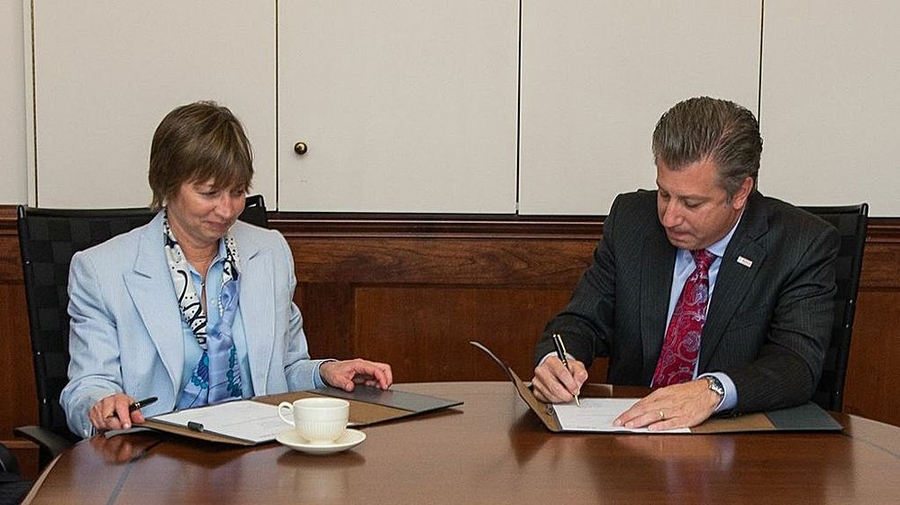Bosch, a leading global supplier of technology and services, renewed its energy research ties with the MIT Energy Initiative (MITEI) on July 29 at a ceremony on campus. The agreement was signed by MIT Vice President for Research Maria Zuber and Robert Bosch, LLC, President Mike Mansuetti.
“We are so proud to work with you in this great endeavor — creating new knowledge, developing new leaders and making important gains against the challenges of our generation and generations to come,” Zuber said at the ceremony.
A member of MITEI since 2008, Bosch will continue as a Sustaining Member and committed another $5 million over a five-year period to fund a research portfolio focused on energy efficiency and renewable energy research projects. Specifically, the research between MIT scientists and Bosch Corporate Research has focused on the search for new materials for electrochemical energy storage, thermoelectric materials for residential heat and electricity co-generation, and ultra-efficient thin-film solar cells.
MITEI’s Director Robert Armstrong, who hosted the signing ceremony, noted that each of these research areas works to answer some of energy’s core challenges: How do we produce zero-carbon electricity? How do we make our system more efficient? And how are we going to provide for intermittent renewables?
“Energy is clearly the world’s preeminent challenge this century,” Armstrong said. “But with that challenge, there’s a wonderful opportunity with science and new ideas to bring a better life to the world’s people with new products to meet those challenges.”
Zuber noted the role Bosch plays in aiding that process, “You bring an understanding of the marketplace that allows us to take what we develop technologically and turn it into products that people need and want to have.”
Bosch will continue to support two competitively awarded fellowships per year for MIT graduate students to conduct research in various energy disciplines. Past fellows have gone on to use their research knowledge to develop novel inventions. Kaitlin Goldstein, a 2010-2011 fellow, for example, was part of a team who won the White House’s Better Buildings Challenge for their plan to upgrade the heating and cooling units in national big-box retail chains. A 2009-2010 fellow, Sophie Ni, won an award for her “smart curtains” that open when attached sensors are exposed to light and close when there is no light, saving energy.
Armstrong quoted Ni as saying, “I was proud to receive funding from a company that shares my passion for technological innovation and my commitment to energy efficiency and sustainability.” Armstrong said this sentiment “captures both MITEI and MIT’s view more generally. It’s really nice to work with a company that shares our values.”
Mansuetti echoed those feelings. “We share MIT’s passion to take research from the lab to the marketplace,” he said. “Like the MIT motto, ‘Mind and Hand,’ Robert Bosch felt that education is best applied for practical purposes…Today at Bosch, we still take a practical approach to the work we do. All of our products are developed under our company motto, ‘Invented for Life.’ So MIT and Robert Bosch, we fit very well together.”
“We are so proud to work with you in this great endeavor — creating new knowledge, developing new leaders and making important gains against the challenges of our generation and generations to come,” Zuber said at the ceremony.
A member of MITEI since 2008, Bosch will continue as a Sustaining Member and committed another $5 million over a five-year period to fund a research portfolio focused on energy efficiency and renewable energy research projects. Specifically, the research between MIT scientists and Bosch Corporate Research has focused on the search for new materials for electrochemical energy storage, thermoelectric materials for residential heat and electricity co-generation, and ultra-efficient thin-film solar cells.
MITEI’s Director Robert Armstrong, who hosted the signing ceremony, noted that each of these research areas works to answer some of energy’s core challenges: How do we produce zero-carbon electricity? How do we make our system more efficient? And how are we going to provide for intermittent renewables?
“Energy is clearly the world’s preeminent challenge this century,” Armstrong said. “But with that challenge, there’s a wonderful opportunity with science and new ideas to bring a better life to the world’s people with new products to meet those challenges.”
Zuber noted the role Bosch plays in aiding that process, “You bring an understanding of the marketplace that allows us to take what we develop technologically and turn it into products that people need and want to have.”
Bosch will continue to support two competitively awarded fellowships per year for MIT graduate students to conduct research in various energy disciplines. Past fellows have gone on to use their research knowledge to develop novel inventions. Kaitlin Goldstein, a 2010-2011 fellow, for example, was part of a team who won the White House’s Better Buildings Challenge for their plan to upgrade the heating and cooling units in national big-box retail chains. A 2009-2010 fellow, Sophie Ni, won an award for her “smart curtains” that open when attached sensors are exposed to light and close when there is no light, saving energy.
Armstrong quoted Ni as saying, “I was proud to receive funding from a company that shares my passion for technological innovation and my commitment to energy efficiency and sustainability.” Armstrong said this sentiment “captures both MITEI and MIT’s view more generally. It’s really nice to work with a company that shares our values.”
Mansuetti echoed those feelings. “We share MIT’s passion to take research from the lab to the marketplace,” he said. “Like the MIT motto, ‘Mind and Hand,’ Robert Bosch felt that education is best applied for practical purposes…Today at Bosch, we still take a practical approach to the work we do. All of our products are developed under our company motto, ‘Invented for Life.’ So MIT and Robert Bosch, we fit very well together.”







